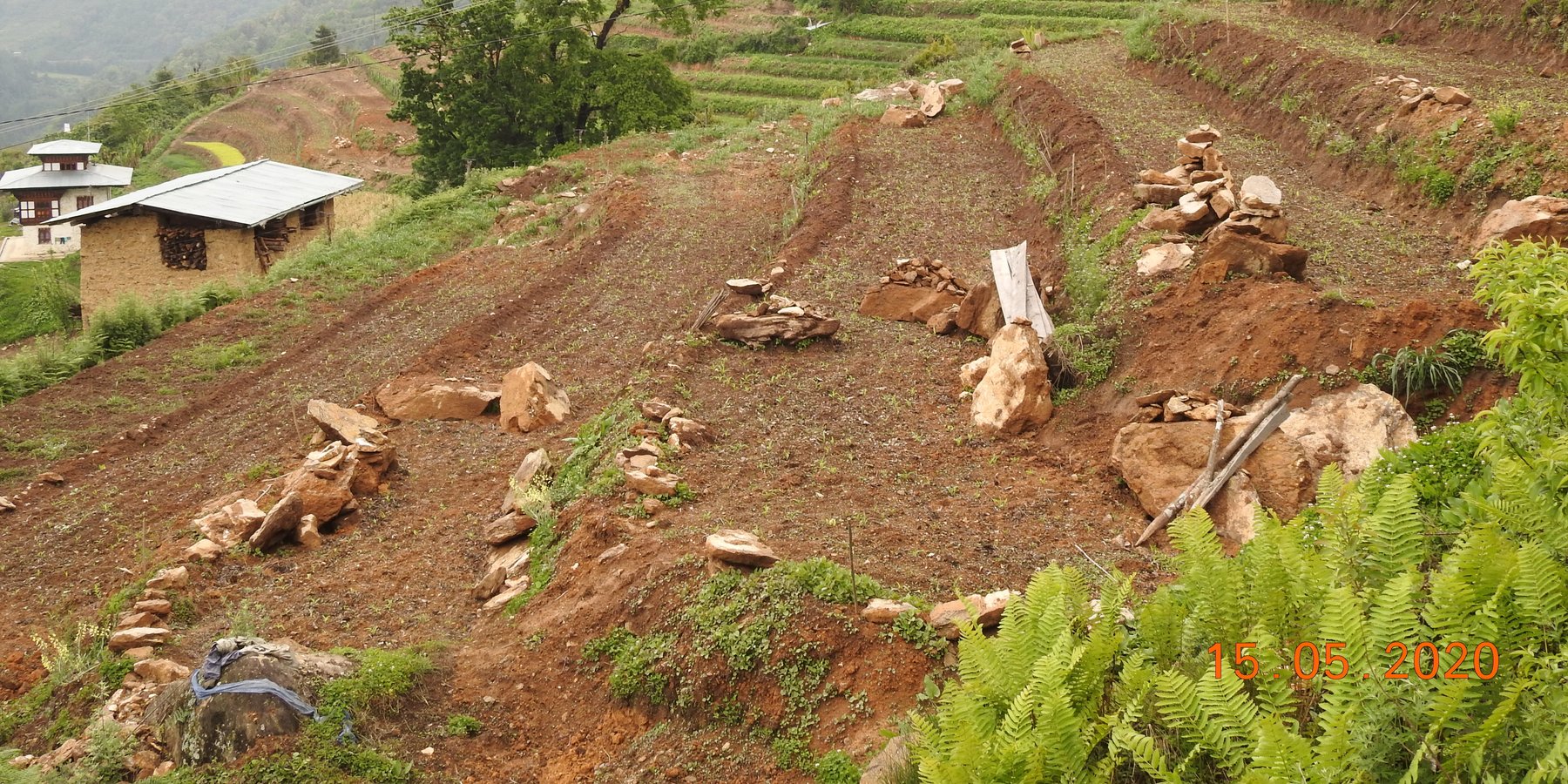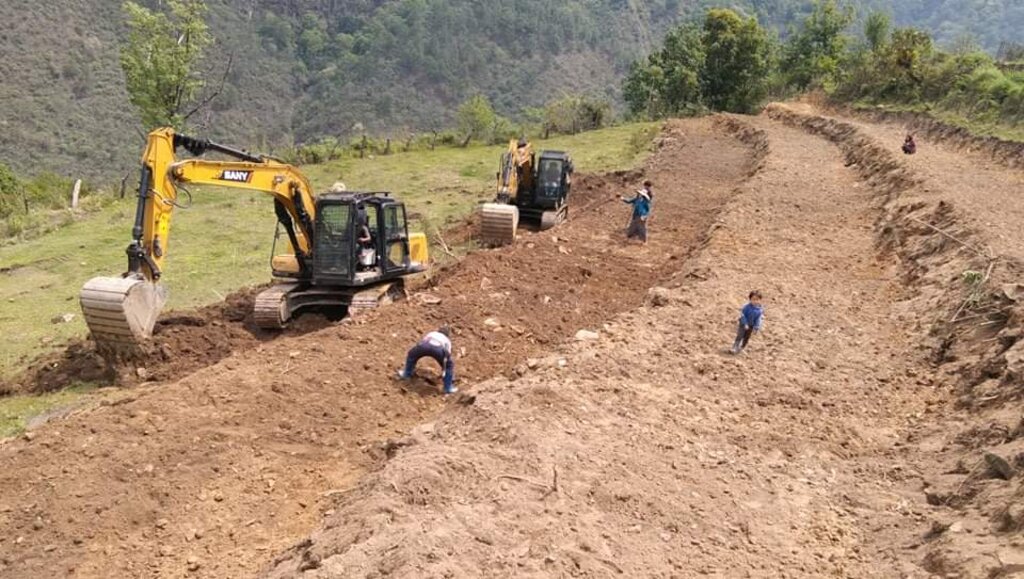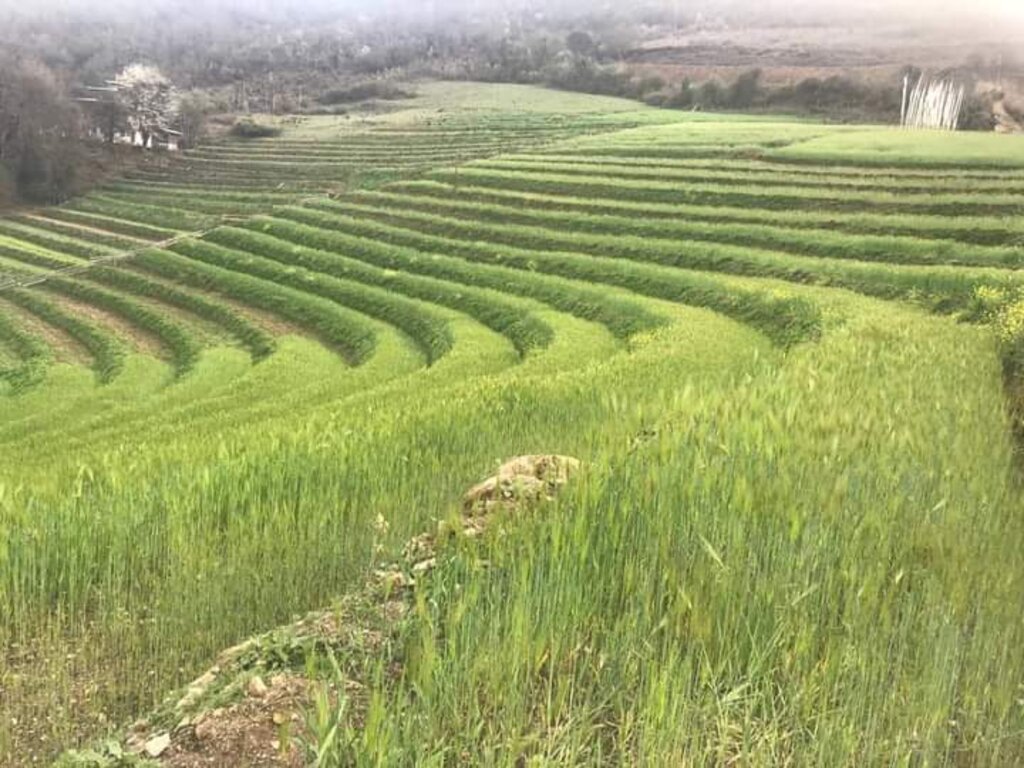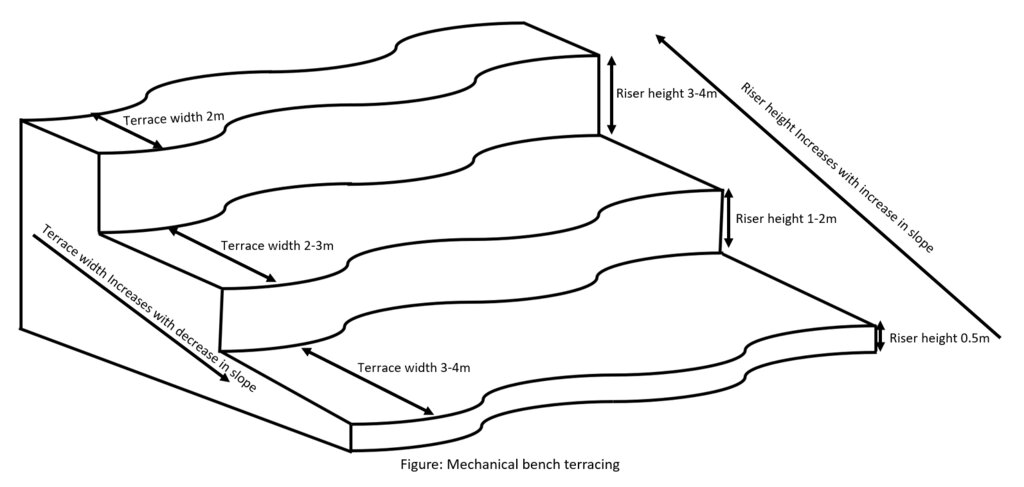Mechanical Bench Terracing [Bhutan]
- Creation:
- Update:
- Compiler: ONGPO LEPCHA
- Editor: Tashi Wangdi
- Reviewers: William Critchley, Rima Mekdaschi Studer, Joana Eichenberger
Thruel Chhey Lag Len Thap Tey Aring Chey Ni (འཕྲུལ་ཆས་ཐོག་ཨ་རིང་བཅད་ནི།)
technologies_6836 - Bhutan
View sections
Expand all Collapse all1. General information
1.2 Contact details of resource persons and institutions involved in the assessment and documentation of the Technology
Key resource person(s)
land user:
Penjor Tenzin
Bemji village
Bhutan
Name of project which facilitated the documentation/ evaluation of the Technology (if relevant)
Strengthening national-level institutional and professional capacities of country Parties towards enhanced UNCCD monitoring and reporting – GEF 7 EA Umbrella II (GEF 7 UNCCD Enabling Activities_Umbrella II)Name of the institution(s) which facilitated the documentation/ evaluation of the Technology (if relevant)
National Soil Services Centre, Department of Agriculture, Ministry of Agriculture & Livestock (NSSC) - Bhutan1.3 Conditions regarding the use of data documented through WOCAT
The compiler and key resource person(s) accept the conditions regarding the use of data documented through WOCAT:
Yes
1.4 Declaration on sustainability of the described Technology
Is the Technology described here problematic with regard to land degradation, so that it cannot be declared a sustainable land management technology?
No
Comments:
The technology is not problematic with regard to land degradation. Indeed, the terraces helps in avoiding and reversing land degradation by reducing surface erosion, retaining soil moisture and improve soil fertility.
2. Description of the SLM Technology
2.1 Short description of the Technology
Definition of the Technology:
Soil erosion by water is one of the major problems in hilly or mountainous countries like Bhutan. In such areas, effective erosion control measures are required to reduce the slope gradient and minimize surface runoff. Among many SLM interventions, mechanical bench terracing is one of the most widely promoted and popular technologies in Bhutan.
2.2 Detailed description of the Technology
Description:
Bhutan is one of the most mountainous countries in the world and agricultural activities are carried out on slopes up to 35 degrees (70 percent). Erosion by water is one of the major causes of land degradation. In such areas, effective erosion control measures include reducing slope gradients to minimize runoff by creating a series of level platforms or “bench terraces” along the contour. Current bench terracing is made using small to medium-sized earthmoving machines called excavators, and thus the technology is called Mechanical Bench Terracing. This is one of the main SLM measures promoted widely and most preferred by landowners who claim that it reduces soil erosion, improves soil fertility, conserves soil moisture, and eases field operations. Bench terraces create impact by 1) helping minimize the risk of soil erosion caused by surface runoff, 2) effectively regulating water flow, and 3) preventing soil saturation by allowing better drainage. Additionally, bench terracing transforms previously unusable or less productive land into cultivable areas, maximizing the utilization of limited land resources. A typical bench terrace on a 20-25 degree slope has a terrace bed of 2-5 m meters and a riser of 0.75 to 1 metre high. The risers are made of earth and the terrace is made flat most of the time to prevent runoff of rainwater.
Establishing and maintaining bench terracing involves a feasibility study of the sites, participatory planning, hands-on training of the landowners, and surveying of contour lines using A-frames. There is also procurement of construction materials, arranging labour and machines and training machine operators. Once constructed, proper water management, soil fertility, and nutrient management practices are crucial for ensuring the long-term sustainability and productivity of the terraced land. Furthermore, knowledge and training on crop cultivation techniques, field management, and maintenance are vital to optimize the benefits.
In summary, bench terracing offers numerous benefits. These include:
1) Overall reduction in land degradation
2) Soil conservation by prevention of erosion by runoff
3) Conservation of soil fertility
3) Increase arable land available for cultivation
4) Ease of mechanized field operations with level terrace beds
5) Water conservation and drainage6) Improved crop production
Land users like the fact that bench terracing provides land that is easier to work. The land is better utilized for cultivation, resulting in improved productivity. Land users generally appreciate its numerous benefits in terms of land productivity, soil conservation, and water management. What they dislike are the expense and labour input if expenditure has to be borne by the land owners and neither machine operators nor small to medium-sized machines are readily available in the market for hire.
2.3 Photos of the Technology
2.5 Country/ region/ locations where the Technology has been applied and which are covered by this assessment
Country:
Bhutan
Region/ State/ Province:
Trongsa Dzongkhag (district)
Further specification of location:
Bemji Village, Nubi Gewog (block), Trongsa Dzongkhag (district)
Specify the spread of the Technology:
- evenly spread over an area
If the Technology is evenly spread over an area, specify area covered (in km2):
1.0097
If precise area is not known, indicate approximate area covered:
- < 0.1 km2 (10 ha)
Is/are the technology site(s) located in a permanently protected area?
No
Map
×2.6 Date of implementation
Indicate year of implementation:
2019
2.7 Introduction of the Technology
Specify how the Technology was introduced:
- through projects/ external interventions
Comments (type of project, etc.):
Mechanical bench terracing in Bemji Village was implemented by Dzongkhag Agriculture Sector with technical support from the National Soil Services Center and funded by GEF-LDCF, UNDP
3. Classification of the SLM Technology
3.1 Main purpose(s) of the Technology
- improve production
- reduce, prevent, restore land degradation
- protect a watershed/ downstream areas – in combination with other Technologies
- create beneficial economic impact
- Improve farm mechanization
3.2 Current land use type(s) where the Technology is applied
Land use mixed within the same land unit:
No

Cropland
- Annual cropping
Annual cropping - Specify crops:
- cereals - rice (wetland)
- cereals - wheat (spring)
- root/tuber crops - potatoes
- vegetables - leafy vegetables (salads, cabbage, spinach, other)
Number of growing seasons per year:
- 2
Specify:
Paddy followed by Wheat or barley
Is intercropping practiced?
No
Is crop rotation practiced?
Yes
If yes, specify:
Paddy followed by wheat or barley/vegetables
Comments:
The crops are grown mostly for self consumption, however, the surplus productions are sold at the weekly local market in Trongsa Dzongkhag (District).
3.3 Has land use changed due to the implementation of the Technology?
Has land use changed due to the implementation of the Technology?
- Yes (Please fill out the questions below with regard to the land use before implementation of the Technology)
Land use mixed within the same land unit:
No

Cropland
- Annual cropping
Annual cropping - Specify crops:
- cereals - barley
- cereals - wheat (spring)
Is intercropping practiced?
No
Is crop rotation practiced?
Yes
If yes, specify:
Paddy followed by Wheat/Barley/vegetables
Comments:
In the past when terracing was not done only flat land was used to grow cereals but sloppy ones were left as grazing land or kept uncultivated. After terracing land user were able to use most of their land for cropping.
3.4 Water supply
Water supply for the land on which the Technology is applied:
- mixed rainfed-irrigated
Comments:
According to the land user, the water supply is mostly rainfed; however, water for irrigation is also readily available.
3.5 SLM group to which the Technology belongs
- cross-slope measure
3.6 SLM measures comprising the Technology

structural measures
- S1: Terraces
3.7 Main types of land degradation addressed by the Technology

soil erosion by water
- Wt: loss of topsoil/ surface erosion
- Wg: gully erosion/ gullying

soil erosion by wind
- Et: loss of topsoil
3.8 Prevention, reduction, or restoration of land degradation
Specify the goal of the Technology with regard to land degradation:
- prevent land degradation
- reduce land degradation
Comments:
Bench terracing is generally constructed to prevent and reduce land degradation due to surface runoff caused by water/rainfall.
4. Technical specifications, implementation activities, inputs, and costs
4.1 Technical drawing of the Technology
Technical specifications (related to technical drawing):
Technical Drawing of bench which are made mechanically
Author:
Ongpo Lepcha
Date:
21/11/2023
4.2 General information regarding the calculation of inputs and costs
Specify how costs and inputs were calculated:
- per Technology area
Indicate size and area unit:
2.4 acres
other/ national currency (specify):
Ngultrum
If relevant, indicate exchange rate from USD to local currency (e.g. 1 USD = 79.9 Brazilian Real): 1 USD =:
80.62
4.3 Establishment activities
| Activity | Timing (season) | |
|---|---|---|
| 1. | Feasibility study | Based on land user and extension agents convenience |
| 2. | Participatory SLM Action planning | Based on land user and extension agent convenience |
| 3. | Hands on training for land owners and machine operator | Prior to actual implementation of the activity |
| 4. | Bench terracing by machine | When the land is fallow (Nov-Feb) |
| 5. | Leveling and removal of stones | Based on land user convenience |
Comments:
It take about three weeks to implement all the activities in 2.40 acres of land
4.4 Costs and inputs needed for establishment
| Specify input | Unit | Quantity | Costs per Unit | Total costs per input | % of costs borne by land users | |
|---|---|---|---|---|---|---|
| Labour | Labour | person-days | 98.0 | 500.0 | 49000.0 | 100.0 |
| Equipment | Excavator | nos | 1.0 | 40916.0 | 40916.0 | |
| Total costs for establishment of the Technology | 89916.0 | |||||
| Total costs for establishment of the Technology in USD | 1115.31 | |||||
If land user bore less than 100% of costs, indicate who covered the remaining costs:
The land owner bore about 32% of the total cost while the remaining cost was covered by the GEF-LDCF Project
4.5 Maintenance/ recurrent activities
| Activity | Timing/ frequency | |
|---|---|---|
| 1. | Maintenance of terrace bunds | When ever necessary |
Comments:
According to the land users, maintenance of the technology involved very little expense because once the terrace was formed the land became more stable.
4.6 Costs and inputs needed for maintenance/ recurrent activities (per year)
Comments:
Once the terraces are well established the maintenance costs are minimal.
5. Natural and human environment
5.1 Climate
Annual rainfall
- < 250 mm
- 251-500 mm
- 501-750 mm
- 751-1,000 mm
- 1,001-1,500 mm
- 1,501-2,000 mm
- 2,001-3,000 mm
- 3,001-4,000 mm
- > 4,000 mm
Specifications/ comments on rainfall:
The data used was from the nearest weather station of the National Center for Hydrology and Meteorology (NCHM).
Indicate the name of the reference meteorological station considered:
https://www.nchm.gov.bt/home/pageMenu/906
Agro-climatic zone
- semi-arid
Warm temperate zone
5.2 Topography
Slopes on average:
- flat (0-2%)
- gentle (3-5%)
- moderate (6-10%)
- rolling (11-15%)
- hilly (16-30%)
- steep (31-60%)
- very steep (>60%)
Landforms:
- plateau/plains
- ridges
- mountain slopes
- hill slopes
- footslopes
- valley floors
Altitudinal zone:
- 0-100 m a.s.l.
- 101-500 m a.s.l.
- 501-1,000 m a.s.l.
- 1,001-1,500 m a.s.l.
- 1,501-2,000 m a.s.l.
- 2,001-2,500 m a.s.l.
- 2,501-3,000 m a.s.l.
- 3,001-4,000 m a.s.l.
- > 4,000 m a.s.l.
Indicate if the Technology is specifically applied in:
- not relevant
5.3 Soils
Soil depth on average:
- very shallow (0-20 cm)
- shallow (21-50 cm)
- moderately deep (51-80 cm)
- deep (81-120 cm)
- very deep (> 120 cm)
Soil texture (topsoil):
- medium (loamy, silty)
Topsoil organic matter:
- high (>3%)
5.4 Water availability and quality
Availability of surface water:
medium
Water quality (untreated):
for agricultural use only (irrigation)
Water quality refers to:
surface water
Is water salinity a problem?
No
Is flooding of the area occurring?
No
Comments and further specifications on water quality and quantity:
However, excess rain can cause flooding in the terrace but instances like this has never happened.
5.5 Biodiversity
Species diversity:
- low
Habitat diversity:
- low
Comments and further specifications on biodiversity:
As most of the terraced fields are properly fenced with electric fencing, the incidences of wild animal crop damage are minimal.
5.6 Characteristics of land users applying the Technology
Sedentary or nomadic:
- Sedentary
Market orientation of production system:
- mixed (subsistence/ commercial)
Off-farm income:
- less than 10% of all income
Relative level of wealth:
- rich
Individuals or groups:
- individual/ household
Level of mechanization:
- mechanized/ motorized
Gender:
- men
Age of land users:
- elderly
5.7 Average area of land used by land users applying the Technology
- < 0.5 ha
- 0.5-1 ha
- 1-2 ha
- 2-5 ha
- 5-15 ha
- 15-50 ha
- 50-100 ha
- 100-500 ha
- 500-1,000 ha
- 1,000-10,000 ha
- > 10,000 ha
Is this considered small-, medium- or large-scale (referring to local context)?
- large-scale
Comments:
In total, land users have around 23 acres of land, however the technology was applied on 2.40 acres of land.
5.8 Land ownership, land use rights, and water use rights
Land ownership:
- individual, titled
Land use rights:
- individual
Water use rights:
- communal (organized)
Are land use rights based on a traditional legal system?
Yes
Specify:
The traditional legal system in our country is as per the Land Act and the Land Rules and Regulations of the Kingdom of Bhutan, which dictate the overall land use in the country.
5.9 Access to services and infrastructure
health:
- poor
- moderate
- good
education:
- poor
- moderate
- good
technical assistance:
- poor
- moderate
- good
employment (e.g. off-farm):
- poor
- moderate
- good
markets:
- poor
- moderate
- good
energy:
- poor
- moderate
- good
roads and transport:
- poor
- moderate
- good
drinking water and sanitation:
- poor
- moderate
- good
financial services:
- poor
- moderate
- good
6. Impacts and concluding statements
6.1 On-site impacts the Technology has shown
Socio-economic impacts
Production
crop production
Quantity before SLM:
Before 1,814 kgs/acre
Quantity after SLM:
After bench terracing 1,971 kgs/acre
Comments/ specify:
According to the land user, there has been increased crop production.
crop quality
Comments/ specify:
According to the land user, the quality has relatively improved but is unable to describe the changes, however, he observed changes in the size of the grain and enhanced grain filling ability.
product diversity
Quantity before SLM:
In the past, the land owner has been growing only wheat or barley
Quantity after SLM:
Now the owner is growing paddy followed by wheat or barley in a year
Comments/ specify:
The land user shared that the number of crops grown in the area has increased, and people also started commercial farming.
production area
Quantity before SLM:
23 acres of land
Quantity after SLM:
2.4 acres of land are currently being cultivated after bench terracing
Comments/ specify:
This is probably due to the lack of labour and some of the farm lands located very far from the home/settlement.
land management
Comments/ specify:
The land users shared that after bench terracing, the management of land has greatly improved. This is evident from the quality of crops that they grow on the terrace. Working on the land is also easy unlike working on slopes.
Income and costs
expenses on agricultural inputs
Quantity before SLM:
Before bench terracing the owner used oxen for ploughing
Quantity after SLM:
Now they use power tillers and cost have reduced for agriculture farming
Comments/ specify:
Other objective of promoting bench terracing is also to enable farm mechanization.
farm income
Comments/ specify:
Before bench terracing the land owners use the field for growing only wheat or barley. After bench terracing they grow two crops in a year, paddy followed by wheat or barley
Ecological impacts
Water cycle/ runoff
surface runoff
Comments/ specify:
Since the land is on a sloping area there is surface and rill erosion in the past, but after the bench terracing, the incidences of surface and rill erosions are minimal
excess water drainage
Comments/ specify:
As the terraces field are used for paddy cultivation there is no excess water. Even if there is excess the land owner can easily drainage to water ways
Climate and disaster risk reduction
landslides/ debris flows
Comments/ specify:
Erosion was easily observable in the past due to the agricultural land being on mountain slopes. However, now, due to the series of levelled land, water erosion and landslides are no longer observed.
6.2 Off-site impacts the Technology has shown
water availability
Comments/ specify:
Before terracing rainwater is lost due to surface runoff however with terracing surface runoff is prevented as a result the amount of irrigation water required has reduced. Thus increasing water availability.
6.3 Exposure and sensitivity of the Technology to gradual climate change and climate-related extremes/ disasters (as perceived by land users)
Gradual climate change
Gradual climate change
| Season | increase or decrease | How does the Technology cope with it? | |
|---|---|---|---|
| annual temperature | increase | well | |
| annual rainfall | increase | very well |
Climate-related extremes (disasters)
Meteorological disasters
| How does the Technology cope with it? | |
|---|---|
| local rainstorm | well |
| local thunderstorm | very well |
| local hailstorm | not well |
| local snowstorm | not well |
Hydrological disasters
| How does the Technology cope with it? | |
|---|---|
| landslide | well |
Biological disasters
| How does the Technology cope with it? | |
|---|---|
| epidemic diseases | not well |
| insect/ worm infestation | not well |
6.4 Cost-benefit analysis
How do the benefits compare with the establishment costs (from land users’ perspective)?
Short-term returns:
slightly positive
Long-term returns:
positive
How do the benefits compare with the maintenance/ recurrent costs (from land users' perspective)?
Short-term returns:
slightly positive
Long-term returns:
slightly positive
Comments:
The land users were not able to explain very clearly the benefits of the technology. This is because land users were supported by the government for the establishment of the terrace. They didn't have any idea how much would it cost if they had to do everything by themselves.
6.5 Adoption of the Technology
- > 50%
If available, quantify (no. of households and/ or area covered):
16 hhs covering 19.50 acres of vulnerable land were brought under bench terracing in Bemje village
Of all those who have adopted the Technology, how many did so spontaneously, i.e. without receiving any material incentives/ payments?
- 0-10%
6.6 Adaptation
Has the Technology been modified recently to adapt to changing conditions?
No
6.7 Strengths/ advantages/ opportunities of the Technology
| Strengths/ advantages/ opportunities in the land user’s view |
|---|
| Agronomic management and working have become relatively easier: with bench terracing working with animals or machinery for tillage activities becomes very easy unlike in slopes. |
| Land can be better utilized, despite decreased total cultivated land: Terrace provides land users the option to fully utilize the available land. If it was a slope, even if they have more land they cannot use them for farming. |
| Prevents the degradation of the land by rain: The main purpose of terracing is to reduce and prevent land degradation caused by surface runoff. |
| Irrigation water is better utilized and conserved: When the surface is properly leveled irrigation water is well distributed. |
| Strengths/ advantages/ opportunities in the compiler’s or other key resource person’s view |
|---|
| Prevents landslide: Since the surveyed area was located on the mountain slopes, there are chances of slides if measures were not taken and bench terraces were not made. |
6.8 Weaknesses/ disadvantages/ risks of the Technology and ways of overcoming them
| Weaknesses/ disadvantages/ risks in the land user’s view | How can they be overcome? |
|---|---|
| It is a very expensive affair: If machinery and laborers have to be managed by individual land users it would be very expensive. | However, in Bhutan, the technology is mostly funded by the project and Government of Bhutan |
| Land users could not convert all available land into the terrace. | More support from the government so that they can convert all slopy areas into terraces. |
| Weaknesses/ disadvantages/ risks in the compiler’s or other key resource person’s view | How can they be overcome? |
|---|---|
| Since bench terracing required huge expenditure it is difficult for the owners to bear the full cost | To implement the intervention through donars fund on cost sharing basis |
7. References and links
7.1 Methods/ sources of information
- field visits, field surveys
One household
- interviews with land users
One individual
When were the data compiled (in the field)?
09/07/2023
7.2 References to available publications
Title, author, year, ISBN:
Bizoza, A. R. (2011). Institutional Economic Analysis of Bench Terraces in The Highlands of Rwanda. Farmers, Institution and Land Conservation. Wageningen University
Available from where? Costs?
https://core.ac.uk/download/pdf/29235864.pdf
Title, author, year, ISBN:
Mesfin, A. (2016). A Field Guideline on Bench Terrace Design and Construction. Ministry of Agriculture and Natural Resources
Available from where? Costs?
https://nrmdblog.files.wordpress.com/2016/04/bench-terrace-manual.pdf
Title, author, year, ISBN:
Dorji, S. (2017). Soil Conservation in Serthi Gewog: A Case Study. Samdrup Jongkhar Initiative.
Available from where? Costs?
http://www.sji.bt/wp-content/uploads/2017/04/Soil-Conservation-Pilot-Impact-Area.pdf
Title, author, year, ISBN:
BTFEC. (2019). Evaluation of Sustainable Land and Management and Innovative Financing to Enhance Climate Resilience and Food Security in Bhutan. BTFEC.
Available from where? Costs?
http://www.bhutantrustfund.bt/wp-content/uploads/2020/01/CIF-Report1.pdf
Title, author, year, ISBN:
Sustainable Land Management: Guidelines and Best Practices 2021
Available from where? Costs?
http://www.nssc.gov.bt
7.3 Links to relevant online information
Title/ description:
Turning slopes, dry land into viable agricultural land in Trongsa
URL:
https://www.undp.org/bhutan/stories/turning-slopes-dry-land-viable-agricultural-land-trongsa
Title/ description:
Bench Terraces: Classification and Maintenance | Soil Management
URL:
https://www.soilmanagementindia.com/soil-erosion/terracing/bench-terraces-classification-and-maintenance-soil-management/15307
Links and modules
Expand all Collapse allLinks
No links
Modules
No modules







